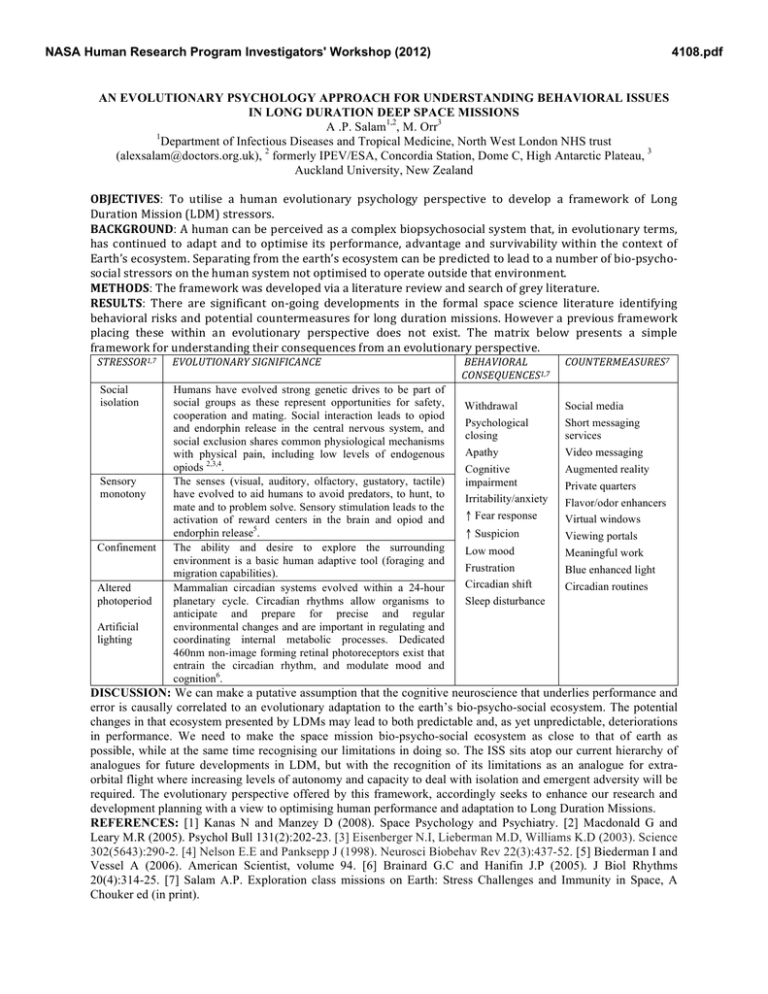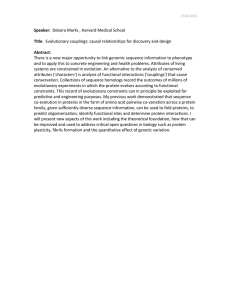AN EVOLUTIONARY PSYCHOLOGY APPROACH FOR UNDERSTANDING BEHAVIORAL ISSUES
advertisement

NASA Human Research Program Investigators' Workshop (2012) 4108.pdf AN EVOLUTIONARY PSYCHOLOGY APPROACH FOR UNDERSTANDING BEHAVIORAL ISSUES IN LONG DURATION DEEP SPACE MISSIONS A .P. Salam1,2, M. Orr3 1 Department of Infectious Diseases and Tropical Medicine, North West London NHS trust (alexsalam@doctors.org.uk), 2 formerly IPEV/ESA, Concordia Station, Dome C, High Antarctic Plateau, 3 Auckland University, New Zealand OBJECTIVES: To utilise a human evolutionary psychology perspective to develop a framework of Long Duration Mission (LDM) stressors. BACKGROUND: A human can be perceived as a complex biopsychosocial system that, in evolutionary terms, has continued to adapt and to optimise its performance, advantage and survivability within the context of Earth’s ecosystem. Separating from the earth’s ecosystem can be predicted to lead to a number of bio-­‐psycho-­‐ social stressors on the human system not optimised to operate outside that environment. METHODS: The framework was developed via a literature review and search of grey literature. RESULTS: There are significant on-­‐going developments in the formal space science literature identifying behavioral risks and potential countermeasures for long duration missions. However a previous framework placing these within an evolutionary perspective does not exist. The matrix below presents a simple framework for understanding their consequences from an evolutionary perspective. STRESSOR1,7 Social isolation Sensory monotony Confinement Altered photoperiod Artificial lighting EVOLUTIONARY SIGNIFICANCE Humans have evolved strong genetic drives to be part of social groups as these represent opportunities for safety, cooperation and mating. Social interaction leads to opiod and endorphin release in the central nervous system, and social exclusion shares common physiological mechanisms with physical pain, including low levels of endogenous opiods 2,3,4. The senses (visual, auditory, olfactory, gustatory, tactile) have evolved to aid humans to avoid predators, to hunt, to mate and to problem solve. Sensory stimulation leads to the activation of reward centers in the brain and opiod and endorphin release5. The ability and desire to explore the surrounding environment is a basic human adaptive tool (foraging and migration capabilities). Mammalian circadian systems evolved within a 24-hour planetary cycle. Circadian rhythms allow organisms to anticipate and prepare for precise and regular environmental changes and are important in regulating and coordinating internal metabolic processes. Dedicated 460nm non-image forming retinal photoreceptors exist that entrain the circadian rhythm, and modulate mood and cognition6. BEHAVIORAL CONSEQUENCES1,7 COUNTERMEASURES7 Withdrawal Social media Psychological closing Short messaging services Apathy Video messaging Augmented reality Cognitive impairment Irritability/anxiety Private quarters ↑ Fear response Flavor/odor enhancers Virtual windows ↑ Suspicion Viewing portals Low mood Meaningful work Blue enhanced light Frustration Circadian shift Circadian routines Sleep disturbance DISCUSSION: We can make a putative assumption that the cognitive neuroscience that underlies performance and error is causally correlated to an evolutionary adaptation to the earth’s bio-psycho-social ecosystem. The potential changes in that ecosystem presented by LDMs may lead to both predictable and, as yet unpredictable, deteriorations in performance. We need to make the space mission bio-psycho-social ecosystem as close to that of earth as possible, while at the same time recognising our limitations in doing so. The ISS sits atop our current hierarchy of analogues for future developments in LDM, but with the recognition of its limitations as an analogue for extraorbital flight where increasing levels of autonomy and capacity to deal with isolation and emergent adversity will be required. The evolutionary perspective offered by this framework, accordingly seeks to enhance our research and development planning with a view to optimising human performance and adaptation to Long Duration Missions. REFERENCES: [1] Kanas N and Manzey D (2008). Space Psychology and Psychiatry. [2] Macdonald G and Leary M.R (2005). Psychol Bull 131(2):202-23. [3] Eisenberger N.I, Lieberman M.D, Williams K.D (2003). Science 302(5643):290-2. [4] Nelson E.E and Panksepp J (1998). Neurosci Biobehav Rev 22(3):437-52. [5] Biederman I and Vessel A (2006). American Scientist, volume 94. [6] Brainard G.C and Hanifin J.P (2005). J Biol Rhythms 20(4):314-25. [7] Salam A.P. Exploration class missions on Earth: Stress Challenges and Immunity in Space, A Chouker ed (in print).





